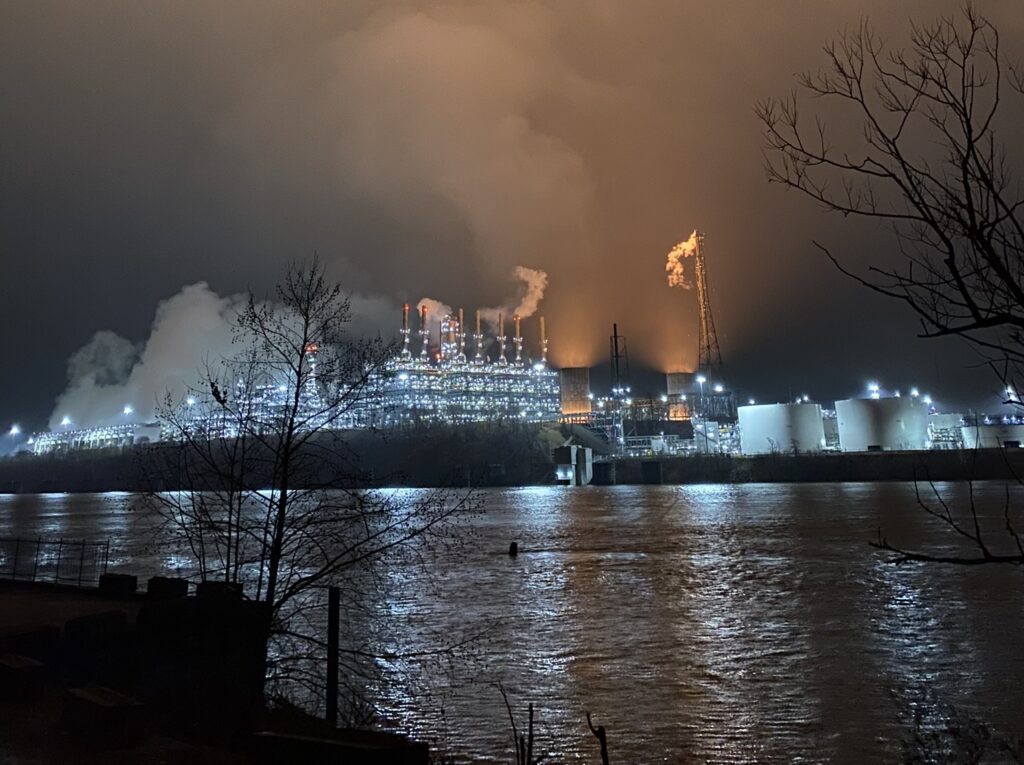EIP’s Center for Environmental Investigations researches and writes ground-breaking, in-depth reports based on public records and data for distribution to the media and public. The Environmental Integrity Project’s unique blend of skill sets — including from our journalists, analysts, and environmental law experts — allows us to produce insightful and newsworthy reports on a variety of environmental topics, from industrial pollution to environmental enforcement.
EIP has been successful in partnering with major media outlets — providing data, documents, and expertise to The New York Times, NBC National News, The Washington Post, the Houston Chronicle and many other publications. Our work was featured in more than 2,000 news stories in 2023, including on National Public Radio and in Reuters, the Associated Press, The Washington Post and The Philadelphia Inquirer.
As part of our research process, we file Freedom of Information Act requests with government agencies, comb through industry reports, crunch numbers, and interview and photograph people out in the field whose lives and stories illustrate the impacts of pollution. Our reports are known for being thorough, well-documented, accessible and clear, and often feature data maps and granular local data that news outlets across the country use to localize and personalize national environmental issues.
In addition to working with the news media, we also share our online databases and libraries of public records — free of charge — with community groups, scientific researchers, and environmental organizations across the country. Examples include our public databases on oil and gas infrastructure, groundwater contamination from coal ash dumps and questionable personal spending by the Trump Administration EPA. On top of written reports and databases, we also produce the Environmental Integrity Podcast to share our research with the public. It is available on Apple Podcasts/iTunes and SoundCloud. Tom Pelton, a national award-winning environmental journalist and Co-Director of the EIP Center for Environmental Investigations, hosts the weekly public radio program, The Environment in Focus.
The bottom line: EIP’s reports spur action, hold polluters and governments accountable, and solve pressing environmental problems. For example, EIP’s investigations into questionable travel spending helped force the resignation of EPA Administrator Scott Pruitt in July 2018. Our 2016 report, “Don’t Drink the Water,” inspired federal funding for the construction of a new water filtration plant for a lower-income Latino community in Bruni, Texas, south of San Antonio. EIP also helped to halt the construction of what would have been North America’s largest trash-burning incinerator, in South Baltimore, in 2016.
Recent Investigative Reports
Feeding the Plastics Industrial Complex

Summary: An EIP investigation found that the rapid growth of plastics manufacturing plants in the U.S. over the last decade has been funded in part by billions of dollars in taxpayer subsidies. But those government funds are also helping to pay for dangerous, and often illegal, air pollution that disproportionately harms communities of color that live near plastics factories – with little or no consequences. Two thirds of the 50 plastics plants built or expanded in the U.S. since 2012 have received a total of almost $9 billion in public subsidies. But 84 percent of those plants violated their pollution control permits – including by releasing benzene, a carcinogen. None of the plants was forced to give up their public subsidies, no matter how serious the violations.
Media: At least 300 news stories were published or aired about EIP’s report, including on NPR national, as well as in the Houston Chronicle, New Orleans Times Picayune, Louisiana Advocate, Politico, Greenwire, Houston Public Media, Texas Tribune, Grist, the Hill, WWNO-FM in New Orleans, WHYY-FM in Philadelphia, WBUR-FM in Boston, the Lexington Herald-Leader, Inside Climate News, and Louisiana Illuminator.

Many on Gulf Coast Say Time is Running out for EPA to Act on Toxic Air
EIP partnered with a team of reporters for The Washington Post to research EPA’s slowness to crack down on carcinogenic benzene air pollution from oil refineries along the Gulf Coast. Over several months, EIP’s analysts and technical experts provided Post journalists with EPA records and data about enforcement trends and fenceline monitoring for benzene on the perimeter between refineries and the communities nearby. The Post also performed its own independent research, including by digging into the failures of environmental enforcement by EPA’s Region 6 office in Dallas. When the story was published on the front page of The Washington Post on Dec. 21, 2023, the newspaper gave credit to the Environmental Integrity Project in three places in the story.
Oil’s Unchecked Outfalls

Summary: EIP’s national study of water pollution from oil refineries reveals that EPA is failing in its legal responsibilities to regulate the half billion gallons of wastewater a day that pours out of U.S. refineries, loaded with nitrogen, industrial salts, cyanide, arsenic, chromium, selenium, and other pollutants.
Media: At least 219 news stories were written or broadcast about the report, including on NPR national, Reuters, The Chicago Tribune, the New Orleans Times-Picayune, The Los Angeles Times, The San Francisco Chronicle, Inside Climate News, The New Republic, Grist, WHYY-FM in Philadelphia, The Indianapolis Star, Houston Public Media, and WGN-TV and radio in Chicago, among many others.
The Clean Water Act at 50

Summary: A half century after the passage of the landmark federal Clean Water Act, and almost four decades after the law’s deadline for all waters across the U.S. to be “fishable and swimmable,” 50 percent of assessed river and stream miles – 703,417 miles nationally — are so polluted they are classified as “impaired,” according to EIP’s report, “The Clean Water Act at 50: Promises Half Kept at the Half Century Mark.” To conduct the research, EIP’s team of analysts and journalists examined state water quality reports to EPA for all 50 states, scrutinized EPA Inspector General’s Office reports, studied journal articles by water quality scientists, and investigated and wrote profiles about five states that have some of the worst water pollution in the U.S. (Indiana, Florida, Delaware, California, Louisiana and Iowa.)
Media: At least 617 news articles, editorials, radio shows and TV programs, including on National Public Radio, and in The New York Times, The Hill, USA Today, The Indianapolis Star, High Country News (in Colorado), Michigan Public Radio, the Herald and News (in Oregon), WFSU in Florida, the Deseret News in Salt Lake City, Utah, and others.
Blind Eye to Big Chicken

Summary: An EIP examination of more than 5,000 pages of Maryland Department of the Environment (MDE) inspection reports revealed that 84 percent of Maryland’s factory-scale poultry operations inspected by the state between 2017 and 2020 violated their state water pollution control permits. But the state issued fines for only four percent of these facilities, and actually collected the penalties for two percent. EIP’s report inspired 145 news stories and a special hearing of the state legislature over the failures of MDE oversight. During a grilling before a state Senate committee in January 2022, Maryland’s Secretary of the Environment promised to increase inspections of poultry operations by 50 percent within a year and hire 66 percent more poultry inspectors (bringing the total from two to five).
Media: 145 news articles, editorials, radio shows and TV programs in The Baltimore Sun, The Washington Post, The Associated Press, WYPR public radio in Baltimore, WBAL-TV and radio, Maryland Matters, Annapolis Capital, Salisbury Daily Times, and The Maryland Reporter.
The Thin Green Line

Summary: During a time of deep cuts to the U.S. EPA and claims by the Trump Administration that state environmental agencies would pick up the slack, EIP found that state pollution control programs have often been slashed even more than at the federal level. We examined state budget records from 2008 to 2018 and found that 30 states cut funding and 40 reduced staffing at their environmental agencies, including by reducing oversight and inspection staff in the oil boom states of Texas and Pennsylvania.
Media: At least 416 news stories, including in The Los Angeles Times, The Washington Post, NPR, Houston Chronicle, USA Today, The Associated Press, The Chicago Tribune, and The Philadelphia Inquirer.
Coal’s Poisonous Legacy

Summary: EIP examined newly available monitoring data and found that 91 percent of U.S. coal-fired power plants are contaminating groundwater with unsafe levels of toxic pollutants.
Media: At least 453 news stories, including by The Washington Post, CNN, Reuters, The Charlotte Observer, Arkansas Times, Bloomberg News, and The Guardian.
Monitoring for Benzene at Oil Refinery Fencelines

Summary: EIP examined fenceline air monitoring data for more than 100 oil refineries across the U.S. and found that 10 were releasing cancer-causing benzene into nearby communities at concentrations above federal action levels.
Media: At least 214 news stories, including in The Washington Post, The Associated Press, The Houston Chronicle, The Texas Tribune, Reuters, The Guardian, and The New Orleans Times-Picayune.
Water Pollution from Slaughterhouses

Summary: EIP examined EPA records for 98 large meat-processing plants that released more than 250,000 gallons per day into waterways and found that 74 of the plants had exceeded their permit limits for nitrogen, fecal bacteria, or other pollutants at least once.
Media: At least 115 news stories. Also, Illinois Senator Dick Durbin wrote a letter to EPA Administrator Andrew Wheeler demanding action to reduce water pollution from slaughterhouses nationally in response to EIP’s report.
Preparing for the Next Storm

Summary: EIP analyzed industrial emissions during Hurricane Harvey to determine that plants waited too long to shutdown, thus driving up their emissions due to flood-driven emergencies, equipment failures, and electrical outages that could have been minimized by taking preventative measures.
Media: At least 382 news stories, including three stories in the The Houston Chronicle (two on the front page), plus an op-ed.
Staff

Tom Pelton
Co-Director of the Center for Environmental Investigations
Since 2014, Tom has served as Director of Communications for the Environmental Integrity Project. From 1997 until 2008, he was a reporter at The Baltimore Sun, where he was twice named one of the best environmental reporters in America by the Society of Environmental Journalists. He is author of the book, The Chesapeake in Focus: Transforming the Natural World, published by Johns Hopkins University Press.

Courtney Bernhardt
Co-Director of the Center for Environmental Investigations
Courtney is the Director of Research for the Environmental Integrity Project. Courtney’s work ranges from managing our online database of coal ash groundwater pollution (www.Ashtracker.org), conducting citizen air monitoring in southwest Baltimore and on the Eastern Shore of Maryland, diving into spreadsheets of state and federal government data to identify the nation’s biggest polluters, and analyzing scientific articles and government records.

Abel Russ
Senior Attorney
Abel works on litigation and research related to coal ash, agricultural sources of water pollution, and risk assessment. He joined EIP in 2010 after graduating from Vermont Law School, where he served as an editor of the Vermont Journal of Environmental Law and as a clinician with the Environmental and Natural Resources Law Clinic. Prior to law school, Abel worked in the field of human health risk assessment as a research associate and as a toxicologist.

Ari Phillips
Writer/Editor
Ari joined EIP in 2018 after working as an environmental reporter and editor. His work has been published by Grist, Gizmodo, Mother Jones, ThinkProgress, Wired, and numerous other outlets.

Brendan Gibbons
Oil & Gas Writer and Editor
Brendan joined EIP in June 2022 after working as an environmental reporter for the San Antonio Express-News and as senior reporter for the San Antonio Report. An avid outdoorsman, he launched The Trailist, a column reviewing hiking, biking and paddling trails in the San Antonio area. Before moving to Texas, he covered the oil and gas industry in Pennsylvania and other environmental subjects as a reporter for The Times-Tribune in Scranton, Pa. In the nonprofit sector, before joining EIP Brendan served as assistant manager of a Texas clean water advocacy organization, the Greater Edwards Aquifer Alliance.

Keene Kelderman
Senior Research Analyst
Keene joined the Environmental Integrity Project in 2016. Before joining EIP, Keene biked across the country from Washington, D.C. to Seattle, WA, where he and two friends raised money for Conservation International.

Louisa Markow
GIS Analyst
Louisa joined the Environmental Integrity Project in 2021. Prior to joining EIP, she worked as an AmeriCorps GIS Assistant for the National Park Service in Atlanta, GA, and a student researcher for the National Oceanic and Atmospheric Administration. She holds a B.S. in Conservation Biology and minor in Mathematics from Colorado State University.

Alexandra Shaykevich
Research Analyst
Alexandra primarily supports our Oil and Gas Program. Prior to joining EIP, she worked as a Research Assistant for the Gas Exporting Countries Forum, an intergovernmental organization based in Doha, Qatar.



